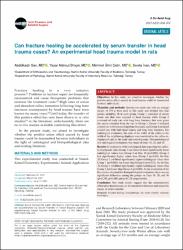| dc.contributor.author | Sarı, Abdulkadir | |
| dc.contributor.author | Dinçel, Yaşar Mahsut | |
| dc.contributor.author | Çetin, Mehmet Ümit | |
| dc.contributor.author | İnan, Sevda | |
| dc.date.accessioned | 2022-05-11T14:12:30Z | |
| dc.date.available | 2022-05-11T14:12:30Z | |
| dc.date.issued | 2021 | |
| dc.identifier.issn | 2687-4784 | |
| dc.identifier.issn | 2687-4792 | |
| dc.identifier.uri | https://doi.org/10.52312/jdrs.2021.8 | |
| dc.identifier.uri | https://hdl.handle.net/20.500.11776/5582 | |
| dc.description.abstract | Objectives: In this study, we aimed to investigate whether the positive union effect caused by head trauma could be transferred between individuals.& nbsp; Materials and methods: Seventy-two male rats with an average weight of 375 g were used in this study and divided into four groups including 18 in each group. Group 1 consisted of serum donor rats that were exposed to head trauma, while Group 2 consisted of study rats with long bone fractures that were given the serum obtained from the rats in Group 1, Group 3 included control rats with isolated long bone fractures, and Group 4 included control rats with both head trauma and long bone fractures. For radiological evaluation, the ratio of the width of the callus to the width of the neighboring diaphysis was considered as the callus-todiaphyseal ratio in the study and control groups. Histopathological and radiological evaluations was made on Days 10, 20, and 30.& nbsp; Results: In evaluation of the radiological data regarding the callusto-diaphyseal ratio, Group 3 was found to have significantly lower radiological values than Group 4 on Day 10 (p=0.006). Group 2 had significantly higher values than Group 3 (p=0.02). On Day 20, Group 2 exhibited significantly higher radiological values than Group 3 (p=0.004), but lower than Group 4 (p=0.032). As for Day 30, Group 2 exhibited significantly higher radiological values than Group 3, but lower than Group 4 (p=0.001). In the evaluation of the Huo scores obtained for histopathological evaluation, there was no significant difference among the groups on Days 10, 20, and 30 (p=0.295, p=0.569, and p=0.729, respectively).& nbsp; Conclusion: Our study results suggest that the osteoinductive effect after head trauma can be transmitted between individuals by means of serum transfer. | en_US |
| dc.language.iso | eng | en_US |
| dc.publisher | Turkish Joint Diseases Foundation | en_US |
| dc.identifier.doi | 10.52312/jdrs.2021.8 | |
| dc.rights | info:eu-repo/semantics/openAccess | en_US |
| dc.subject | Fracture healing | en_US |
| dc.subject | histopathology | en_US |
| dc.subject | rat | en_US |
| dc.subject | serum transfer | en_US |
| dc.subject | traumatic brain injury | en_US |
| dc.subject | Brain-Injury | en_US |
| dc.title | Can fracture healing be accelerated by serum transfer in head trauma cases? An experimental head trauma model in rats | en_US |
| dc.type | article | en_US |
| dc.relation.ispartof | Joint Diseases and Related Surgery | en_US |
| dc.department | Fakülteler, Tıp Fakültesi, Cerrahi Tıp Bilimleri Bölümü, Ortopedi ve Travmatoloji Ana Bilim Dalı | en_US |
| dc.department | Fakülteler, Tıp Fakültesi, Cerrahi Tıp Bilimleri Bölümü, Tıbbi Patoloji Ana Bilim Dalı | en_US |
| dc.authorid | 0000-0003-3416-5666 | |
| dc.authorid | 0000-0001-6576-1802 | |
| dc.authorid | 0000-0001-9827-8892 | |
| dc.authorid | 0000-0001-8138-5851 | |
| dc.identifier.volume | 32 | en_US |
| dc.identifier.issue | 2 | en_US |
| dc.identifier.startpage | 306 | en_US |
| dc.identifier.endpage | 312 | en_US |
| dc.institutionauthor | Sarı, Abdulkadir | |
| dc.institutionauthor | Dinçel, Yaşar Mahsut | |
| dc.institutionauthor | Çetin, Mehmet Ümit | |
| dc.institutionauthor | İnan, Sevda | |
| dc.relation.publicationcategory | Makale - Uluslararası Hakemli Dergi - Kurum Öğretim Elemanı | en_US |
| dc.authorscopusid | 57196712908 | |
| dc.authorscopusid | 55994580900 | |
| dc.authorscopusid | 57208565301 | |
| dc.authorscopusid | 56320836200 | |
| dc.authorwosid | çetin, mehmet ümit/AAA-4905-2022 | |
| dc.authorwosid | sari, abdulkadir/AAF-3143-2021 | |
| dc.authorwosid | INAN, SEVDA/E-3364-2018 | |
| dc.authorwosid | sari, abdulkadir/ABH-3293-2021 | |
| dc.identifier.wos | WOS:000661415100005 | en_US |
| dc.identifier.scopus | 2-s2.0-85108553209 | en_US |
| dc.identifier.pmid | 34145805 | en_US |



















